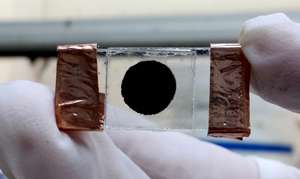Dye-sensitized solar cell absorbs a broad range of visible and infrared wavelengths

Dye-sensitized solar cells (DSSCs) rely on dyes that absorb light to mobilize a current of electrons and are a promising source of clean energy. Jishan Wu at the A*STAR Institute of Materials Research and Engineering and colleagues in Singapore have now developed zinc porphyrin dyes that harvest light in both the visible and near-infrared parts of the spectrum1. Their research suggests that chemical modification of these dyes could enhance the energy output of DSSCs.
DSSCs are easier and cheaper to manufacture than conventional silicon solar cells, but they currently have a lower efficiency. Ruthenium-based dyes have been traditionally used in DSSCs, but in 2011 researchers developed a more efficient dye based on a zinc atom surrounded by a ring-shaped molecule called a porphyrin. Solar cells using this new dye, called YD2-o-C8, convert visible light into electricity with an efficiency of up to 12.3 per cent. Wu's team aimed to improve that efficiency by developing a zinc porphyrin dye that can also absorb infrared light.
The most successful dyes developed by Wu's team, WW-5 and WW-6, unite a zinc porphyrin core with a system of fused carbon rings bridged by a nitrogen atom, known as an N-annulated perylene group. Solar cells containing these dyes absorbed more infrared light than YD2-o-C8 and had efficiencies of up to 10.5 per cent, matching the performance of an YD2-o-C8 cell under the same testing conditions (see image).
Theoretical calculations indicate that connecting the porphyrin and perylene sections of these dyes by a carbon–carbon triple bond, which acts as an electron-rich linker, improved the flow of electrons between them. This bond also reduced the light energy needed to excite electrons in the molecule, boosting the dye's ability to harvest infrared light.
Adding bulky chemical groups to the dyes also improved their solubility and prevented them from aggregating—something that tends to reduce the efficiency of DSSCs.
However, both WW-5 and WW-6 are slightly less efficient than YD2-o-C8 at converting visible light into electricity, and they also produce a lower voltage. "We are now trying to solve this problem through modifications based on the chemical structure of WW-5 and WW-6," says Wu.
Comparing the results from more perylene–porphyrin dyes should indicate ways to overcome these hurdles, and may even extend light absorption further into the infrared. "The top priority is to improve the power conversion efficiency," says Wu. "Our target is to push the efficiency to more than 13 per cent in the near future."
More information: Luo, J., Xu, M., Li, R., Huang, K.-W., Jiang, C. et al. N-annulated perylene as an efficient electron donor for porphyrin-based dyes: Enhanced light-harvesting ability and high-efficiency Co(II/III)-based dye-sensitized solar cells. Journal of the American Chemical Society 136, 265–272 (2014). DOI: 10.1021/ja409291g





















